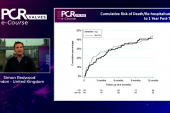Obstructive CAD Can Be Left Alone Before TAVI, Observational Data Suggest
(UPDATED) CAD, even triple-vessel or left main disease, should not invoke a knee-jerk reaction to stent before TAVI, says Rishi Puri.

Coronary artery disease may not need to be treated before dealing with symptomatic severe aortic stenosis (AS), data from a single, high-volume medical center suggest.
In a series of nearly 2,000 patients, there were no differences in all-cause mortality or major adverse cardiovascular events between those with coronary artery disease, even those with high- and extreme-risk obstructive disease, and those without coronary lesions.
“We've been doing this diligently now for a number of years,” senior investigator Rishi Puri, MD, PhD (Cleveland Clinic, OH), told TCTMD. “In our experience, these patients do very well with TAVR first as it then allows you to tackle the coronary disease in good time in a stable, controlled fashion.”
Puri said that their analysis, which was published last week in the European Heart Journal, showed that even in patients deemed extreme risk, such as those with lesions 70% or greater in three major epicardial vessels, procedural outcomes were just as good as in those without coronary artery disease. Unplanned coronary revascularizations were higher in the group with obstructive disease versus the group without disease, with event curves separating early.
“It tended to be in concordance with the natural history of plaque burden and the number of diseased vessels that you see in those patients,” said Puri. “The more diseased vessels you have, the more likely you are to have a coronary event. We found that their natural history was really reflective of their underlying disease burden, but it doesn't necessarily mean that you need to clean up the coronaries and do high-risk PCI before you do TAVR or definitely do it afterwards.”
Instead, these data suggest a TAVI-first approach is best, followed by a guideline-driven, objective approach to tackling residual coronary artery disease, said Puri.
Rodrigo Bagur, MD, PhD (Western University/London Health Sciences Centre, Canada), who wasn’t involved in the study, said these data support prior analyses, including a meta-analysis and systematic review performed several years back. In that analysis, Bagur, who was the study’s senior author, showed that those who underwent coronary revascularization prior to TAVI had a higher rate of major vascular complications, as well as a higher rate of death at 30 days, when compared with those who weren’t revascularized.
“The more we do, everything goes in the same direction,” he told TCTMD. “In our center, we are even more conservative because we have not evolved compared to the United States, where the cutoff [for TAVI] is 65 years old. We’re still treating 75- and 80-year-old people. Our approach is just get the TAVI done because people die of aortic stenosis. They don't die from chronic coronary syndromes.”
David Wood, MD (University of British Columbia/Vancouver General Hospital, Canada), agreed that that accumulating data suggests it’s safe not to treat coronary artery disease prior to TAVI, noting that they take a similar approach to care.
“Our pattern of practice in Vancouver, myself and John Webb, has been ‘less is more,’” Wood told TCTMD. “We treat the valve because that is the most severe proximal epicardial stenosis. I've always loved that line—I forget who said it—but the most proximal severe epicardial stenosis is aortic stenosis, because it's before the coronaries even start.”
Finally, David Hildick-Smith, MD (Brighton and Sussex University Hospitals NHS Trust, Brighton, England), said the “timely and helpful” study also supports clinical practice at most UK centers.
“If the patient has unequivocally severe aortic stenosis, they should get their TAVI first,” he told TCTMD, noting that the data shows that it’s safe. “If the patient has remaining symptoms post-procedure and has coronary disease of note, that can be treated after. We don’t need to treat the coronary disease before the TAVI—and in fact it offers some jeopardy to do so.”
Optimal Timing, if Any, Debated
The optimal treatment strategy for patients with concomitant CAD and AS is frequently debated still, with studies attempting to determine the best timing for addressing CAD in patients scheduled for TAVI. To date, the randomized trial data are limited.
In 2020, the ACTIVATION trial, which included 235 patients with AS and at least one significant coronary stenosis in a major epicardial artery, found no difference in the risk of death or rehospitalization at 12 months between those who underwent PCI before TAVI and those who did not. The trial was hamstrung, though, because it was stopped early and failed to demonstrate noninferiority of preprocedure PCI. Still, data from other sources, including the REVASC-TAVI registry, showed similar results.
These patients do very well with TAVR first as it then allows you to tackle the coronary disease in good time in a stable, controlled fashion. Rishi Puri
At this time, the US and European guidelines do not give clear recommendations on the optimal timing of revascularization, or if it’s needed at all, in patients undergoing TAVI. The European Association of Percutaneous Cardiovascular Interventions issued a statement last year that said PCI should be done before TAVI in patients with severe coronary disease (> 50% stenosis in the left main or > 70% in other vessels) in the proximal segment.
At the Cleveland Clinic, physicians have adopted a conservative approach when it comes to managing stable obstructive CAD in patients eligible for TAVI. They proceed with TAVI first in those where it’s most likely that symptoms are attributable to AS, even in cases where the patient has complex, multivessel CAD.
Among the 1,911 patients eligible for analysis in the observational study, 1,432 (75%) had no obstructive disease while 116 were classified as having intermediate-risk CAD, 199 high-risk CAD, and 164 extreme-risk CAD. Extreme risk was defined as obstructive triple-vessel disease or significant left main disease (≥ 70%), while high risk was defined as obstructive disease in two vessels or proximal LAD lesions ≥ 70%. High-risk patients also included those with left main lesions ≥ 50% but less than 70%. Finally, intermediate-risk CAD included those with significant single-vessel disease in the left circumflex or right coronary artery as well as those with nonproximal LAD lesions.
During a median follow-up of 21 months, the incidence rate of all-cause mortality, MACE, or post-TAVI unplanned coronary revascularization—the study’s primary endpoint—was 227 and 240 per 1,000 patient-years of follow-up in the nonobstructive and obstructive CAD groups, respectively (P = 0.47). There were no differences in the risks of all-cause mortality or MACE.
Unplanned revascularization was significantly higher in those with obstructive CAD than in those without CAD (16.3 vs 6.0 per 1,000 person-years; P = 0.01). In total, 1.0% of those without CAD underwent either CABG or PCI during follow-up, whereas the revascularization rates were 2.6%, 4.0%, and 2.4% for those with intermediate-, high-, and extreme-risk CAD, respectively (P = 0.006).
Rates of ACS were low overall (1.2%), but significantly higher in patients with obstructive CAD. In those without CAD, 0.7% had ACS during follow-up compared with 1.7%, 4.0%, and 1.2% of those with intermediate-, high-, and extreme-risk CAD, respectively (P < 0.001).
In a multivariate-adjusted risk model, increasing severity or extent of untreated obstructive CAD was not associated with all-cause mortality or MACE when compared with nonobstructive CAD. The high-risk CAD patients did appear to have a higher risk of unplanned revascularization in a univariable analysis, but the numbers were small and a full adjustment wasn’t possible, the researchers say.
Coronary reaccess has come up as a potential roadblock to doing TAVI first, but investigators say the bioprostheses did not negatively affect coronary access in any patient, noting they had no complications or difficulties during left-heart cannulation. During the study period, more than 90% of patients were implanted with the balloon-expandable Sapien 3 (Edwards Lifesciences).
In practice, said Puri, it can be challenging to differentiate symptoms related to the different conditions because not all patients with obstructive disease have angina, while shortness of breath, which is a symptom of aortic stenosis, can also be considered equivalent to angina. In the Cleveland Clinic analysis, 735 patients were excluded because their symptoms were likely attributable to coronary rather than aortic disease; 13% of this subset went on to have PCI within 3 months before TAVI.
Hildick-Smith said that if a patient has moderate-to-severe aortic stenosis, but severe CAD, that can be tricky to know which lesion set is causing the majority of symptoms. “It may be that some of those patients get their coronary disease treated first,” he said.
TAVI-First Has Advantages
Traditionally, said Wood, there has been a bias from interventionalists and referring physicians to want to stent severe coronary lesions before TAVI, usually out of an abundance of caution. “But in 2024, given the registry data and given this recent paper in European Heart Journal, there is just not compelling evidence to do that,” he said.
Wood, who is leading COMPLETE TAVR, which is randomizing patients to optimal medical therapy or PCI performed 1 to 45 days after TAVI, said their 4,000-patient trial has been hampered because physicians are performing ad hoc PCI after discovering significant coronary artery disease in patients who are being worked up for TAVI.
“They see a 90% stenosis in the proximal LAD and would like it treated,” he said. The data would suggest that it’s safe to not treat the patients and randomize them in COMPLETE TAVR. There are techniques coming down the pipeline with leaflet modification so that when we do have to intervene after TAVR, whether it's a tall frame or short frame [bioprosthetic valve], we'll be able to do it.”
To TCTMD, Puri said the TAVI-first strategy has advantages, including that physicians are practicing within the guidelines. While there’s limited advice on revascularization in the setting of aortic stenosis, the guidelines clearly prefer medical therapy over revascularization for those with stable coronary artery disease. Revascularization is recommended only for those with lifestyle-limiting angina despite optimized medical therapy and significant coronary stenoses.
In addition to staying within the realm of the guidelines, Puri said they’ve always believed that PCI, if necessary, would be safest if done after TAVI.
“Your PCI is going to be more stable and safer when you have an intact aortic valve, when your ventricle has been allowed to remodel a little bit and allowed to derive the benefit of unloading compared to when you have an untreated obstructive aortic valve and a ventricle that's been struggling for years dealing with it,” he said.
Our approach is just get the TAVI done because people die of aortic stenosis. Rodrigo Bagur
This is especially true in a higher-risk population where operators are performing complex PCI. Moreover, a TAVI-first strategy means that the procedure is not performed while the patient is taking dual antiplatelet therapy. In ACTIVATION, bleeding events were more frequent in those who underwent PCI prior to TAVI, said Puri.
He emphasized that these new data should not be construed as being anti-PCI.
“We’re saying that you don’t need to have a knee-jerk reaction,” Puri said. “You need to assess the patient. You need to take an individualized approach. Look at the ischemic burden, at how much ischemia may be contributing towards the left ventricular function, the symptomatology. What technical issues could one get into? For example, if you do TAVR first, what valve choice is it going to be if you want to reaccess the coronaries? Because there are differences between short-stem frame valves and long-stem frame valves. You need to put all of it together. You need to be a doctor.”
To TCTMD, Bagur pointed out that there are some factors that can influence the decision to revascularize, noting that > 70% stenosis in the proximal segment of the LAD has been shown to be prognostically significant. However, as this analysis shows, there is no urgency to sending this patient for PCI. Unless the patient presents with clear, classic angina symptoms, Bagur said their approach is not even send pre-TAVI patients for coronary catheterization.
“With this approach, it opens up access for more patients to get procedures done,” he said. “With the coronary angiogram, which for many centers is still a requirement, that's another step in between the patient screening, or patient intake as we call it here, and the TAVI procedure. So you improve flow and program efficiency without compromising a patient's outcome.”
Michael O’Riordan is the Managing Editor for TCTMD. He completed his undergraduate degrees at Queen’s University in Kingston, ON, and…
Read Full BioSources
Persits I, Layoun H, Kondoleon NP, et al. Impact of untreated chronic obstructive coronary artery disease on outcomes after transcatheter aortic valve replacement. Eur Heart J. 2024;Epub ahead of print.
Disclosures
- Puri and Bagur report no relevant conflicts of interest.





Comments